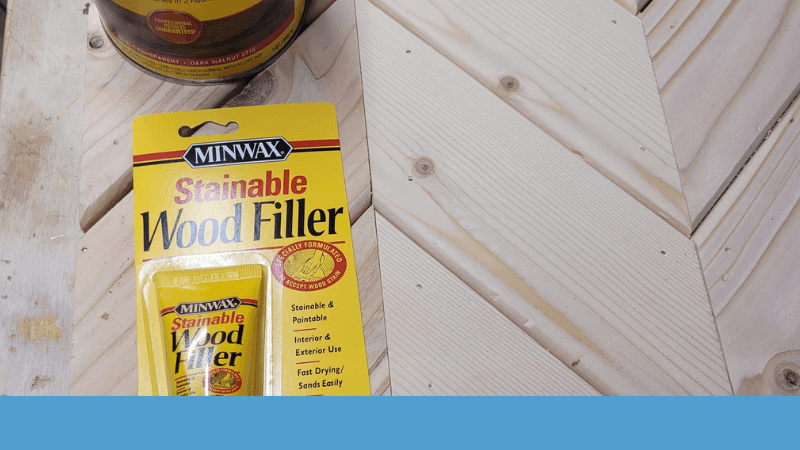Wood filler is a valuable product used to repair imperfections, cracks, or holes in wood surfaces. It’s a paste-like substance that can be applied and sanded down to create a smooth finish. But if you’re thinking of protecting your wood project with a clear, durable, and glossy coating, you might wonder if you can apply polyurethane over wood filler. In this article, we’ll explore the compatibility of these two materials and discuss some essential facts to consider for achieving the desired results.
Understanding Wood Filler

Wood filler, also known as wood putty, is designed to fill gaps and repair damaged wood. It’s typically made from a combination of wood fibers and a binding agent, such as epoxy or vinyl. Wood fillers come in different colors to match various wood tones, making it easier to blend with the surrounding surface. It’s crucial to choose a high-quality wood filler that closely matches the color of your wood or is a darker shade that mimics natural discoloration or knots. This way, the finished item appears as natural as possible.
Polyurethane and Wood Filler Compatibility
Yes, you can apply polyurethane over wood filler. However, it’s essential to be aware that the polyurethane may not match the wood grain or color as closely as it does with the timber. This is because wood fillers are typically less absorbent compared to natural wood, resulting in reduced adherence. To minimize this discrepancy, it’s crucial to choose a wood filler that closely matches the color of your wood or use a darker shade that implies natural discoloration or knots. This helps create a more seamless and natural-looking finish.
Dealing with Compressed Damage
Sometimes, wood surfaces may have compressed damage or indentations that require special attention. To address this issue, you can try a technique that involves soaking the area around the damage with water and then drying it using an electric iron or heat gun. This process may need to be repeated several times, especially if the indentation is deep. With time and patience, the wood grain should eventually return to its original shape.
Best Practices for Applying Polyurethane over Wood Filler
To ensure the best results when applying polyurethane over wood filler, it’s important to follow these best practices:
- Curing Time: Allow the wood filler sufficient time to cure and harden according to the manufacturer’s instructions before applying polyurethane. Rushing this step may lead to cracking or bubbling of the finish.
- Sanding: Before applying polyurethane, carefully sand the wood filler to create a smooth and even surface. Use fine-grit sandpaper and sand gently until the repaired area is flush with the surrounding wood. This step helps the polyurethane adhere properly and ensures a seamless transition between the filler and the wood.
- Cleanliness: Before applying polyurethane, make sure the wood surface is clean and free from dust, dirt, and debris. Use a clean, lint-free cloth or tack cloth to wipe away any residue. Contaminants can affect the adhesion of the polyurethane and impact the final finish.
Hands-on User Experience: Gregory Hinshaw’s Perspective
Gregory Hinshaw, a seasoned woodworker, has shared his personal experience regarding the use of polyurethane over wood filler. Hinshaw, who has been using this technique for over 40 years, affirms that it is indeed possible to apply polyurethane over wood filler. His experience and expertise shed light on a practical application of this method.
According to Hinshaw’s account on Quora.com, he has successfully used Minwax Jacobean stain over Minwax Polyurethane. He describes the process of achieving desirable results by applying a heavy wet coat of stain with a foam brush and immediately wiping off the excess stain with a clean terry cloth rag. He mentions that spot staining can be done by allowing the stain to sit on the desired spot for a while.
Hinshaw also notes the transformative effects of this technique. He states that chips become less noticeable, scratches are almost entirely concealed, and dull areas are rejuvenated. After a drying period of four days, the surface becomes hardened and less sticky.
To ensure the best outcome, Hinshaw suggests lightly sanding the entire piece with 240-grit sandpaper, being careful not to intentionally sand through the polyurethane. In cases where sanding does occur, he advises re-staining the entire piece using the aforementioned method. Finally, Hinshaw recommends applying a fresh coat of polyurethane a day or two later.
It’s important to note that Hinshaw’s experience serves as an individual account and may not necessarily apply to all wood fillers or polyurethane products. Always consider the specific instructions and recommendations provided by the manufacturers of the products you are using to achieve optimal results.
Conclusion: Polyurethane Over Wood Filler
In summary, you can apply polyurethane over wood filler to protect and improve the appearance of your wood projects. Choose a wood filler that matches the wood color or uses a darker shade for a more seamless finish. Allow the wood filler to cure properly, sand it to create a smooth surface, and ensure the wood is clean before applying polyurethane. While individual experiences may vary, following these steps will help you achieve a beautiful and durable finish for your wood projects.